The 2022 Toyota Tundra is replacing a truck that has been on the market — with the exact same engine and transmission — since 2006, so it’s about time Toyota brought its full-size pickup into the modern era. A boosted engine, 10-speed transmission, and coil spring-based suspension help the truck get there, yielding a solid, but not exactly stand-out, vehicle. But that’s the Toyota way, isn’t it?
(Full Disclosure: Toyota invited me to San Antonio — home of its huge truck plant known as TMMTX (Toyota Motor Manufacturing Texas)— to drive the 2022 Toyota Tundra on a ranch. The company paid for my flight, hotel, and nourishment. All of it was far too swanky for a man constantly covered in Red ‘N’ Tacky grease.)
In some ways, Toyota is the Apple of car companies. The Japanese automaker’s vehicles are a default choice for many, as the machines have a reputation for just working and keeping bullshit to a minimum. With that said, technology often lags the competition. For example, the current-generation Toyota Tacoma — which came out in 2015 and which isn’t that different than the previous model — still has rear drum brakes and a six-speed automatic. The last-gen Toyota Corolla, one of the best-selling small cars in the world, could be had with an antiquated four-speed automatic all the way up until 2016.
Toyota likes to kick it old school, and if you ask the company why, its representatives will spit out the acronym “QDR,” which stands for “Quality, Durability and Reliability.” The carmaker wants you to believe that it sticks with older tech because that tech still satisfies customers and meets the company’s QDR targets. “Fifteen years later, [the Tundra] was still meeting our customers’ expectations and doing what it needed to do,” Jay Sackett, executive program manager, told me at the press event.
“Frame development...it’s complex, and when we do it, we want to make sure we do things right and proper,” he said, mentioning that Toyota developed the Tundra alongside its platform mate, the new Toyota Land Cruiser (whose frame has the same side profile and rail width), and that the team was careful to hit its QDR for both machines when developing this new platform.
“It’s very rare for us to make a huge leap,” Sackett admitted. “Toyota is always about continuous improvement and Kaizen. We have what we have, and we understand it works well, and we make [incremental] improvements over time,” he told me, mentioning that the Tundra did have some refreshes along the way, but that though the old vehicle did still satisfy customers, it was time for a new Tundra after 15 model years.
I’m assuming the outgoing truck’s horrendous fuel economy numbers and sub-optimal crash test results were contributing factors.
What Is It?
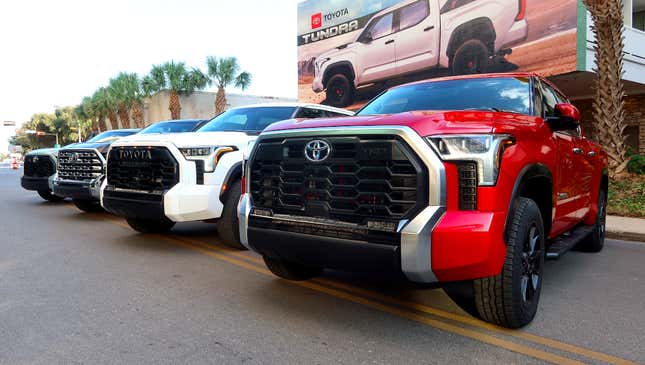
The 2022 Tundra’s frame, body, powertrains, and drivetrain are all new. I’ll get into more technical detail in a later article, but for now, you need to know that the 381 horsepower (at 5,600 RPM), 401 lb-ft V8 is finally gone. Replacing it is a 3.5-liter twin-turbo V6 making 389 horsepower (at 5,200 RPM) and 479 lb-ft of torque. There’s also a hybrid version of that engine that makes 437 horsepower (at 5,200 RPM) and 583 lb-ft of torque. Yes, 583 lb-ft of torque.
The engine architecture is the same as that of the Lexus LS500 sedan’s 3.5-liter twin-turbocharged V6, though Toyota made sure to tell journalists that the engine has been thoroughly truck-ified. Like that LS500, the new Tundra gets a 10-speed automatic transmission to replace the old six-speed.

The 288-volt parallel hybrid system, known in the industry as a “P2" system, is wedged between the engine and transmission bell housing (see orange casing above) and acts to provide boost for increased performance, brake regeneration, and starting capability (a standard 12-volt starter remains for cold-starts). There’s a clutch between the combustion engine and electric motor, allowing for electric-only propulsion during low-load conditions like parking lot maneuvering and steady-state low-speed driving.
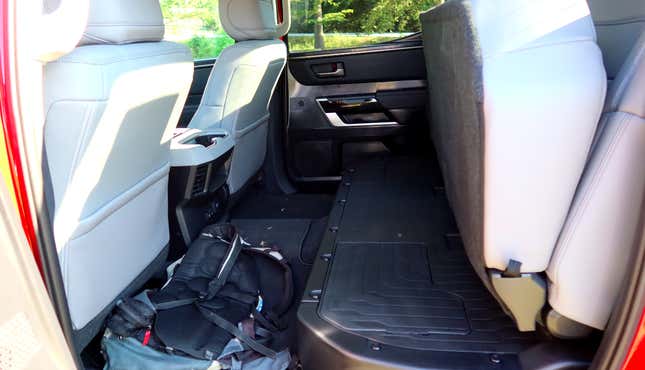
The battery, an air-cooled Nickel-Metal Hydride unit located under the rear bench (on non-hybrid models, this area is storage space), is similar to the one found in the Toyota Sienna minivan, as is the inverter.
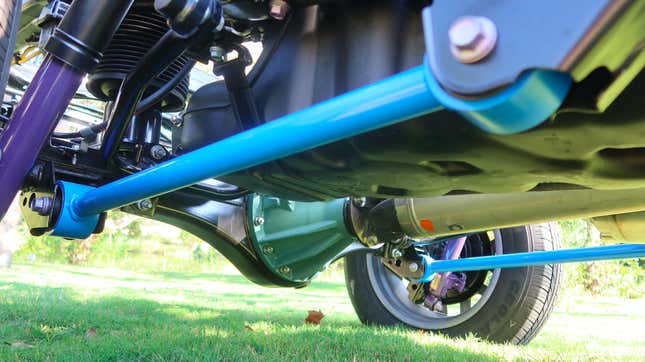
Perhaps the biggest change to the new truck is its Ram 1500-like five-link rear suspension with either coils or air springs. This design replaces the leaf-spring setup found on nearly every Toyota pickup truck ever built.
The image above shows two lower control arms; there are also two upper arms that mitigate axle wrap (the tendency for the axle to twist under load) and a track bar to handle lateral loads. The beauty of this design is that it allows Toyota to decouple certain vehicle performance attributes (such as ride and handling), and tune them individually and precisely. More on the tech in an article later this week.
With a boosted hybrid engine, coil-spring rear suspension, and 10-speed automatic, the new Tundra has finally caught up to the competition with regards to hardware. And in the area of software, Toyota didn’t skimp, either: it developed an infotainment system displayed on a big-screen that acts as the centerpiece of a significantly improved interior.
The Cabin Is Chunky But Functional

The Toyota Tundra’s interior is about as elegant as its grille, which is to say: it’s not.
The interior is “chunky.” The vents are enormous, the shifter feels beefy, and on TRD Pro models, there’s “TOYOTA” written in gigantic letters on the dashboard. Also available on the TRD Pro: a red interior with “techno camo” seats. It’s all a bit much:

There’s something about the Tundra’s interior that just doesn’t feel as premium as the Ram’s:
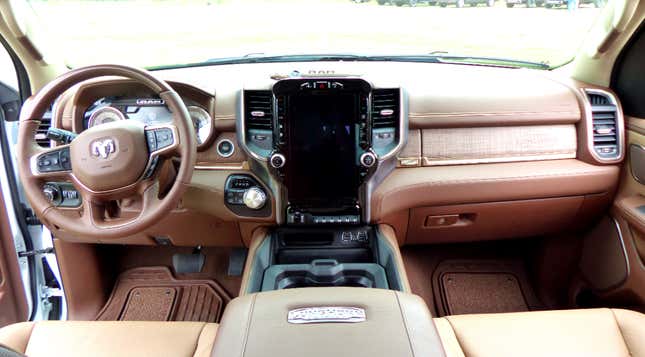
Or as sophisticated as even the F-150's:
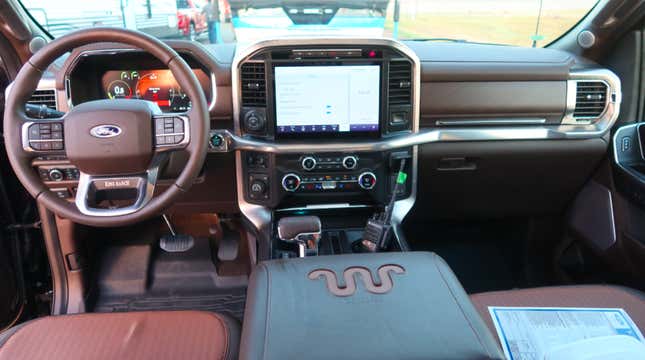
To be clear, I actually like the new Tundra’s cabin. I’m not sure what that says about me, but I don’t mind the Tonka-truck vibes, and I don’t even care that much that some of the plastics are a bit hard. It’s a truck; what’s most important is usability, and in that area, the Tundra shines. There are lots of toggle switches, which are fun, and there are nice, big, flat switches down below that one could press even with a gloved finger.
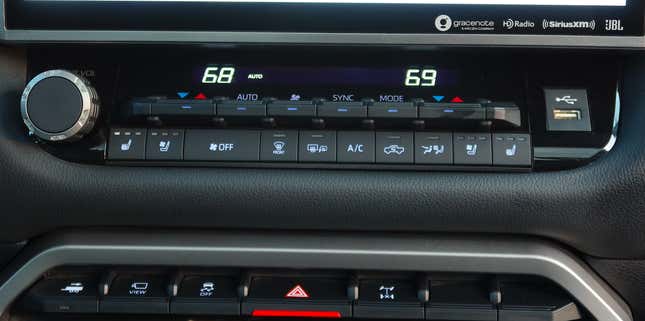
The big volume knob, with rubber grip around its circumference, is easy to use, and so is the rubber-grip-wrapped drive mode selector:
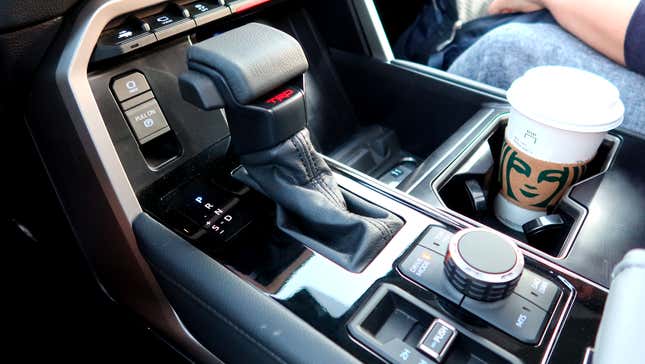
The big shifter isn’t elegant, but it works, and it feels substantial. The four-wheel drive button feels a bit less substantial, but it’s easy to use: you just push the button down (see “push” there on the bottom right of the image above), and slide the shifter. There’s a wireless charging pad with a ledge that lets you place your phone upright, which is nice, as this allows for more usable storage space in the center console area.
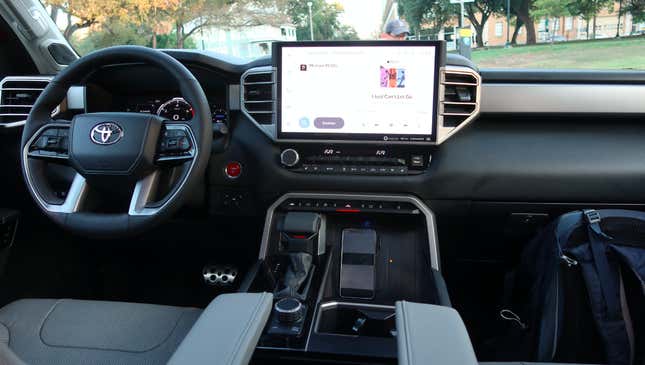
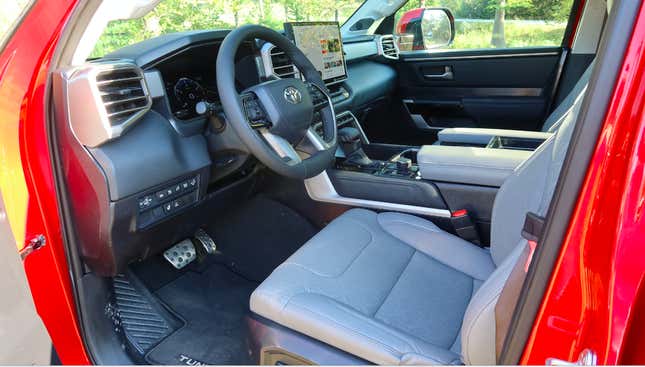
While we’re on the topic of the center console, the Tundra’s cubby is odd; its lid is the shape of a field goal post. Here, allow me to show you what I mean:
Another thing I noticed while inside the Tundra, particularly after having driven the predecessor just minutes prior, was that the new truck’s front DLO (which is what car industry people call windows — it stands for “daylight opening”) felt smaller, particularly in the height dimension. I took a small video demonstrate the difference in front visibility:
And if video isn’t your format, here are some photos. This is the old Tundra:
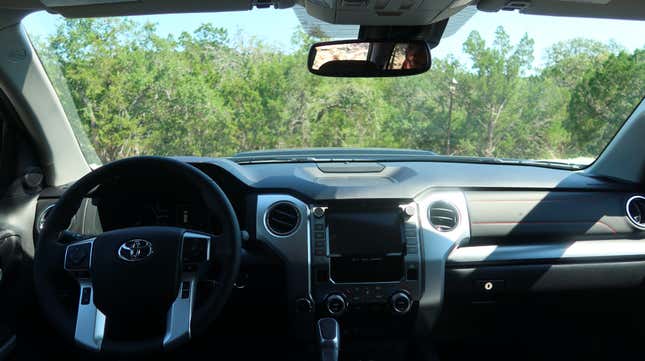
And this is the 2022:
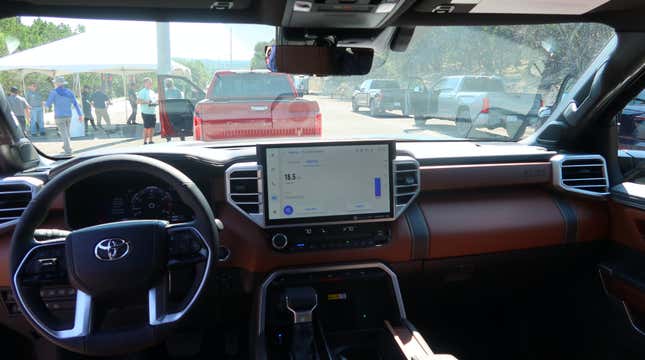
The distance from the top of the dashboard to the top of the windshield is significantly smaller on the new truck, making the cabin feel a bit cave-like initially, though I did get used to it.
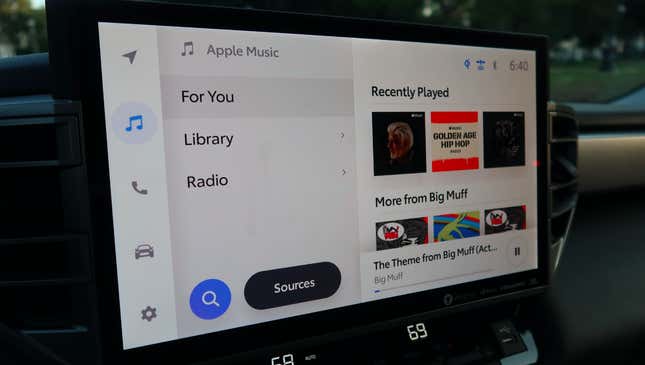
I also got used to the “Toyota Audio Multimedia system” displayed on a 14-inch touchscreen in my truck, though an eight-incher is standard. This infotainment system, developed by Toyota in-house, was superb during the short time that I used it.
The screen is sharp, the software is fast and lag-free (pinching the screen to zoom into a map was as smooth as the best infotainment systems I’ve used), and the layout is intuitive. I might like to have a clean, dedicated home screen — and there might be a way to get one; I only played with this setup briefly — but otherwise Toyota’s infotainment impressed me and my brother Phillip, who is a seasoned tech journalist with lots of knowledge of infotainment systems. If he says it’s good, it’s good.
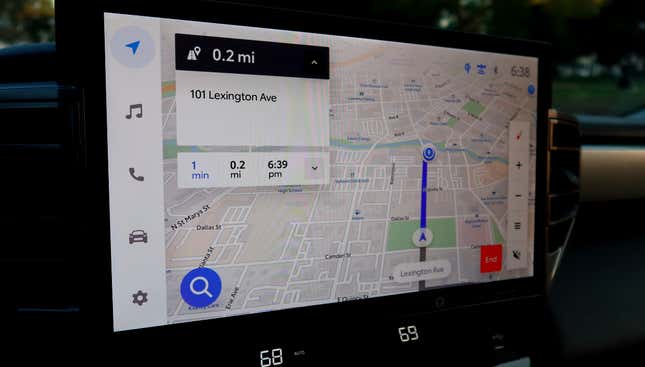
There’s wireless Android Auto and Apple Carplay, a cloud-based navigation system with over-the-air updates, and a lot more that I’m not really that interested in because I care most about what the truck is like to drive. So let’s get into that.
The Tundra Is Not Slow, But It’s Not Exciting
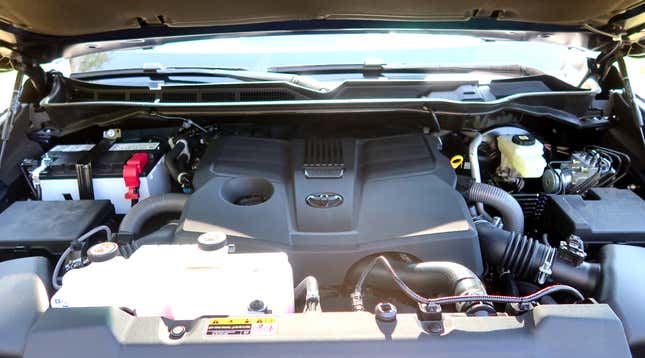
So the big question that everyone wants answered is: How’s the new powertrain? I have to say that, from an enthusiast’s standpoint, it’s a bit of a step backwards.
Toyota had some last-gen Tundras available; in fact, there were so many journalists and so few trucks parked in front of the San Antonio hotel that I actually had no choice but to drive the 2021 model, and boy am I glad I did. The 5.7-liter V8 in that truck is fantastic; it feels powerful, the six-speed transmission downshifts and shoots the V8's revs to the moon, and my god when those revs get up there, are they glorious — I mean, for a modern full-size truck, that is. It’s no Shelby GT350R:
Hopping into the new truck and dropping the throttle pedal leads to aural disappointment. The twin-turbo V6 sounds hollow compared to the old truck’s throaty V8, and honestly, the new boosted engine mated to the 10-speed didn’t really feel much faster, either. And it should, because even though the 389 horsepower output of the new motor is just eight ponies more than the outgoing truck’s V8, those four extra gears and the lower curb weight should combine to make a significant difference. Maybe the truck is quicker, but it’s hard to notice due to how well-isolated the cabin is. (More on that in a bit).

Above are the new truck’s weights, and below are the outgoing truck’s weights. Generally, the new truck is a couple hundred pounds lighter than the outgoing model, though the i-FORCE MAX (the hybrid) is very heavy compared to the non-hybrid trucks of either generation.
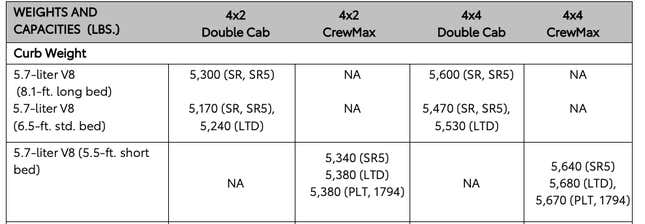
Stomping the accelerator pedal while underway, the 10-speed transmission took a bit of time to downshift, and when it did, it tended to give me a high gear that corresponded with about 3,500-4,000 RPM.
For some reason, I wanted more revs — I wanted more something. Because hammering the throttle and watching the engine spin up to only 3,800 RPM, and then quietly and calmly accelerate the truck forward just made the driving experience feel a bit too tame. The video directly above demonstrates what I’m talking about; the old truck’s six-speed downshifted enough to get that V8 up to 4,500 RPM, at which point the motor made a raucous sound, and I really felt like I was moving. The new truck, with its gas pedal jammed to the floorboard, downshifts to under 4,000 RPM, and the engine quietly and gradually propels the pickup forward.
Even on the hybrid model, acceleration felt gradual; perhaps if I had more time, it’d have been easier to notice the extra grunt from the electric motor, though it’s worth noting again that the hybrid weighs about 500 pounds more. Where I did notice the hybrid powertrain’s benefit was in partial-throttle conditions. Hammer down, and the transmission’s downshift takes some time before the engine (again, at about 3,500 to 4,000 RPM) swiftly pushes the truck forward. But lightly tap the throttle so that it doesn’t induce a downshift, and you’ll notice almost immediate acceleration from that e-motor. It’s nice.
Still, whether in the base engine or hybrid, in some ways the old truck felt quicker, and I don’t know if that’s real, or if it’s a perception thing.
It’s So Quiet And The Ride Is Good
I say this might be a perception thing because the new Tundra’s cabin is so quiet. Drive 55 mph, and it’s like you’re in a sensory deprivation chamber; climb to 65 and you’ll start to hear a bit of wind noise around the mirrors, but that’s about it. Whoever did the NVH development on the new Tundra did an incredible job.
Contributing to that isolated feeling is smooth ride quality. To be sure, I was mostly driving on smooth Texas roads, but even when I hit expansion joints, cobblestones, or asphalt repair patches, the suspension transmitted very little into the cabin.
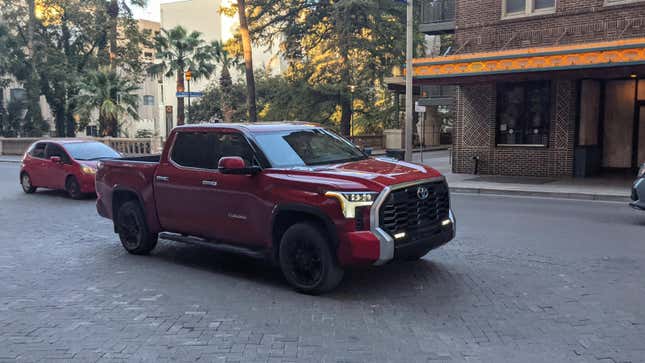
It may not be the sexiest thing, but a quiet, serene, smooth ride is more important to many than is the sound of the truck’s engine or even how quickly it accelerates. Especially if you’re daily-driving, this kind of thing can significantly improve your overall experience, and it’s an area where the Tundra is so proficient, it’s my main takeaway from my test: This truck is seriously comfortable to drive.
It’s Easy To Place Off-Road
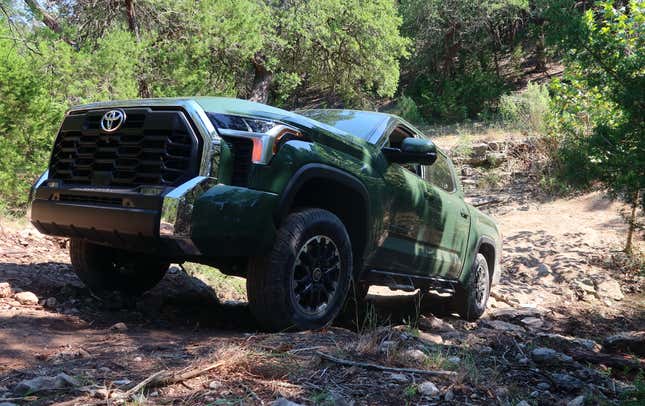
Toyota set up a little off-road course for journalists. There were a few rocky obstacles and some trenches to flex the Tundra’s new suspension, but it was still a moderate trail. The model I drove was a Limited with the TRD Off-Road package.
With skid plates and Falken Wildpeak all-terrain tires, there was decent grip and underbody protection, but without the additional ground clearance of the TRD Pro, the truck only had a 21 degree approach angle and 24 degree departure angle despite the decent ~11 inches of running clearance.
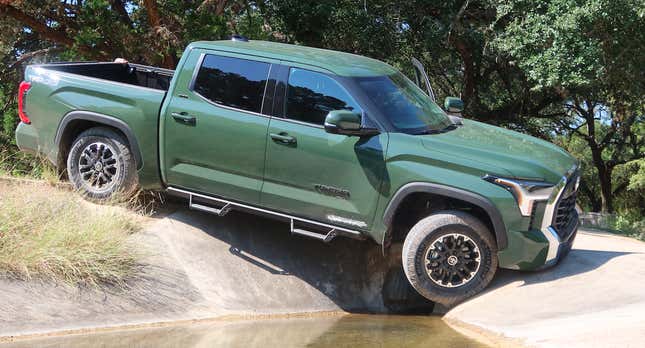
Though I’m sure the TRD Pro, with its acceptable 26.2-degree approach angle, would have been more capable, the fact is that the Tundra is too big to be amazing off-road. There’s just too much chin, belly, and butt to get caught on rocks and stumps.
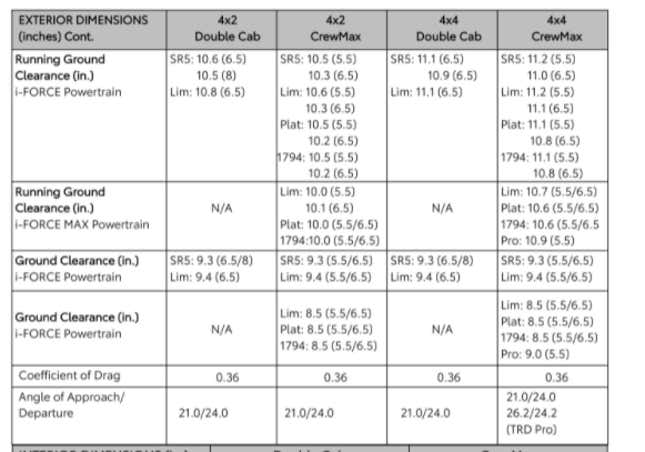
Still, if you need a truck to take camping in the woods on mild dirt or gravel trails, the Tundra will get it done. The rear suspension flexes quite well, there’s plenty of wheel torque in low range to keep you moving, and there’s Crawl Control to help you maintain speed off-road.
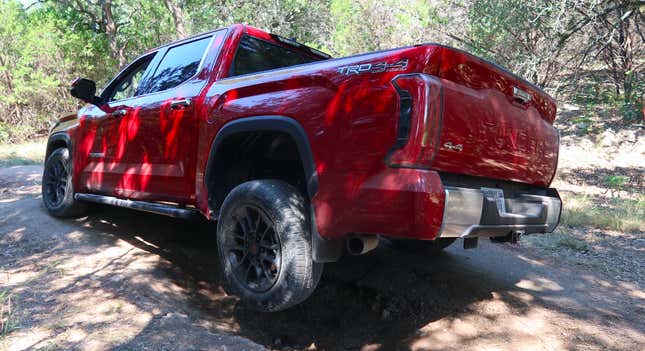
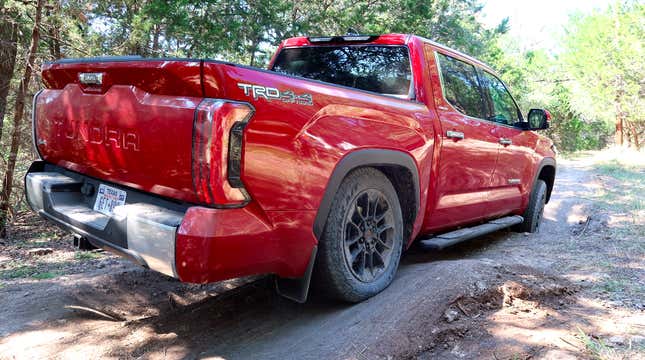
Crawl Control, like Ford’s “Trail Control” (which is similarly excellent), allows the driver to set a vehicle speed, and simply let off the accelerator pedal as the vehicle adjusts engine output automatically to traverse whatever obstacle is in the way; the system also applies brakes when needed. Especially when there’s a big nose to worry about, being able to slowly and precisely place the truck on the trail is critical. Also aiding on that front are the Tundra’s cameras:
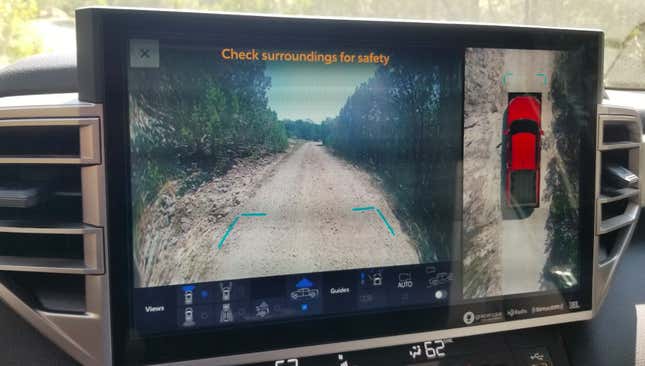
Quality could be better, I have to say, and the distortion on the outer edges is odd. Still, the camera came in clutch off-road, and having a dedicated hard-button for it on the center stack is just smart from a usability standpoint.
The camera, crawl control, and rear locking differential (which I think takes a bit too long to turn on and off) made for beautifully controlled off-roading, even if the truck’s geometry meant that off-road driving wasn’t exactly hard-core. The video above shows another journalist letting the truck drive itself up a rocky ledge.
Verdict
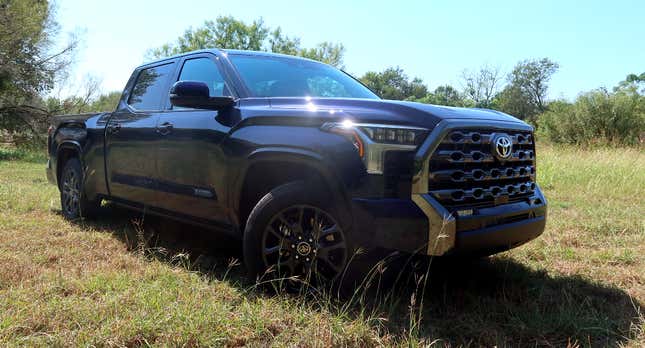
The new Tundra is a thoroughly modern pickup truck, with a 10-speed automatic and twin-turbo hybrid V6 helping bringing refinement and efficiency where it has long been missing. Toyota estimates 18 MPG city, 23 MPG highway, and 20 MPG combined for the base “i-FORCE” non-hybrid engine in two-wheel drive guise. Add a transfer case, front driveshaft, front diff, and some axle shafts, and all three of those numbers drop by a single MPG. That’s not bad when you compare the Tundra to competitors with similar power outputs. Toyota anticipates that the hybrid will be even more efficient, though the company doesn’t have figures available right now. Toyota also hasn’t announced pricing.
There’s a lot that I haven’t mentioned, like the excellent 12,000 pound towing capacity (and Toyota’s Straight Path Assist to help you back up your trailer in a straight line), the just-okay 1,940 max payload rating, the gigantic panoramic moonroof, the driver-assist safety features, and on and on. I only had half a day to drive the truck, so I focused on what the truck was like to drive, and what I learned is that the new Tundra isn’t exciting, but it’s quiet, its ride is smooth, and its interior — while perhaps not the most elegant — is intuitive. Overall, the 2022 Toyota Tundra is a pleasant place to spend time, and that’s a big deal in a country where pickup trucks are daily driven by millions.